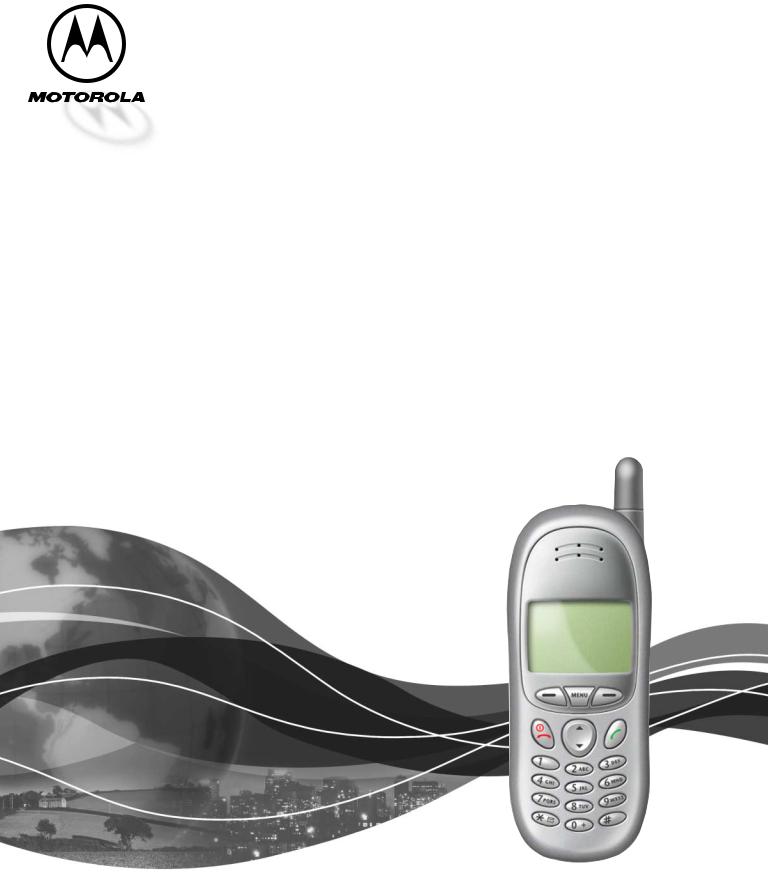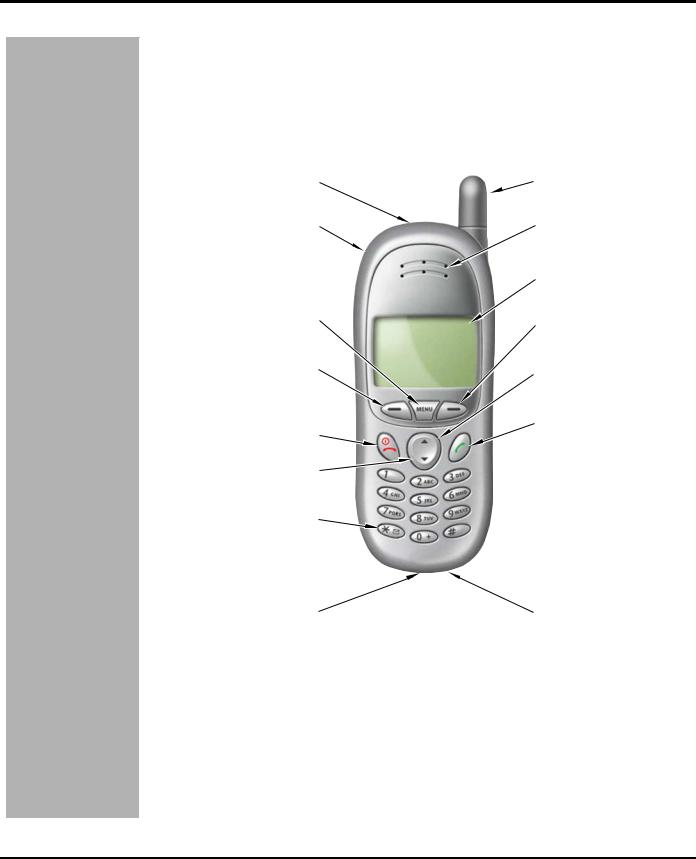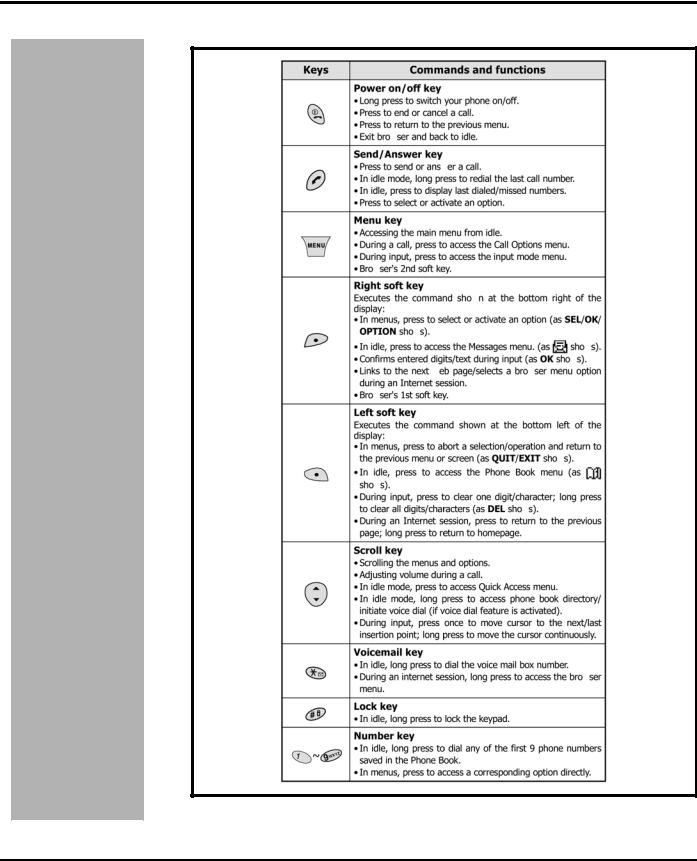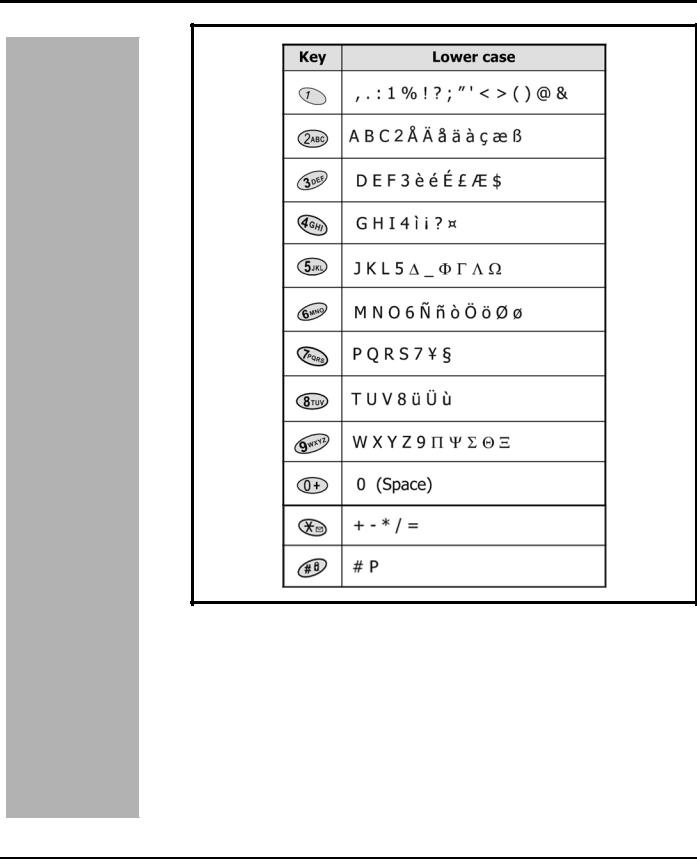Motorola T190, T191 Service Manual

Level 1 and 2 Service Manual
Product Families C25 & C43
Dual Band Wireless Telephone
Talkabout• 191, 190 by Toko (toko@gsm-free.org)

Level 1 and 2 Service Manual |
Table of Contents |
Table of Contents |
|
Index . . . . . . . . . . . . . . . . . . . . . . . . . . . . . . . . . . . . . . . . . . . . . . . . . . . . . . . . . . . . . . . . . . . . . . . . . |
.PRELIMINARY. . . . . Index-1 |
Introduction . . . . . . . . . . . . . . . . . . . . . . . . . . . . . . . . . . . . . . . . . . . . . . . . . . . . . . . . . . . . . . . . . . . . |
. . . . . . . . . . 1 |
Product Identification . . . . . . . . . . . . . . . . . . . . . . . . . . . . . . . . . . . . . . . . . . . . . . . . . . . . . . |
. . . . . . . . . . 1 |
Product Names . . . . . . . . . . . . . . . . . . . . . . . . . . . . . . . . . . . . . . . . . . . . . . . . . . . . . . . . . . . |
. . . . . . . . . . 1 |
Product Changes . . . . . . . . . . . . . . . . . . . . . . . . . . . . . . . . . . . . . . . . . . . . . . . . . . . . . . . . . . |
. . . . . . . . . . 1 |
Regulatory Agency Compliance . . . . . . . . . . . . . . . . . . . . . . . . . . . . . . . . . . . . . . . . . . . . . . |
. . . . . . . . . . 1 |
Computer Program Copyrights . . . . . . . . . . . . . . . . . . . . . . . . . . . . . . . . . . . . . . . . . . . . . . |
. . . . . . . . . . 2 |
About This Service Manual . . . . . . . . . . . . . . . . . . . . . . . . . . . . . . . . . . . . . . . . . . . . . . . . . |
. . . . . . . . . . 2 |
Warranty Service Policy . . . . . . . . . . . . . . . . . . . . . . . . . . . . . . . . . . . . . . . . . . . . . . . . . . . . |
. . . . . . . . . . 3 |
Parts Replacement . . . . . . . . . . . . . . . . . . . . . . . . . . . . . . . . . . . . . . . . . . . . . . . . . . . . . . . . |
. . . . . . . . . . 4 |
Specifications . . . . . . . . . . . . . . . . . . . . . . . . . . . . . . . . . . . . . . . . . . . . . . . . . . . . . . . . . . . . . . . . . |
. . . . . . . . . . 5 |
Product Overview . . . . . . . . . . . . . . . . . . . . . . . . . . . . . . . . . . . . . . . . . . . . . . . . . . . . . . . . . . . . . . . |
. . . . . . . . . . 6 |
Features . . . . . . . . . . . . . . . . . . . . . . . . . . . . . . . . . . . . . . . . . . . . . . . . . . . . . . . . . . . . . . . . . |
. . . . . . . . . . 6 |
General Operation . . . . . . . . . . . . . . . . . . . . . . . . . . . . . . . . . . . . . . . . . . . . . . . . . . . . . . . . . . . . . . . |
. . . . . . . . . . 9 |
Controls, Indicators, and Input / Output (I/O) Connectors . . . . . . . . . . . . . . . . . . . . . . . . |
. . . . . . . . . . 9 |
User Interface Menu Structure . . . . . . . . . . . . . . . . . . . . . . . . . . . . . . . . . . . . . . . . . . . . . . |
. . . . . . . . . 13 |
Alert Settings . . . . . . . . . . . . . . . . . . . . . . . . . . . . . . . . . . . . . . . . . . . . . . . . . . . . . . . . . . . . |
. . . . . . . . . 15 |
Battery Function . . . . . . . . . . . . . . . . . . . . . . . . . . . . . . . . . . . . . . . . . . . . . . . . . . . . . . . . . . |
. . . . . . . . . 15 |
Operation . . . . . . . . . . . . . . . . . . . . . . . . . . . . . . . . . . . . . . . . . . . . . . . . . . . . . . . . . . . . . . . . |
. . . . . . . . . 15 |
Tools and Test Equipment . . . . . . . . . . . . . . . . . . . . . . . . . . . . . . . . . . . . . . . . . . . . . . . . . . . . . . . . |
. . . . . . . . . 17 |
Disassembly . . . . . . . . . . . . . . . . . . . . . . . . . . . . . . . . . . . . . . . . . . . . . . . . . . . . . . . . . . . . . . . . . . . . |
. . . . . . . . . 18 |
Removing and Replacing the Battery . . . . . . . . . . . . . . . . . . . . . . . . . . . . . . . . . . . . . . . . . |
. . . . . . . . . 18 |
Removing and Replacing the Subscriber Identity Module (SIM) . . . . . . . . . . . . . . . . . . . . |
. . . . . . . . . 19 |
Removing and Replacing the Rear Escutcheon . . . . . . . . . . . . . . . . . . . . . . . . . . . . . . . . . |
. . . . . . . . . 20 |
Removing and Replacing the Rear Housing . . . . . . . . . . . . . . . . . . . . . . . . . . . . . . . . . . . . |
. . . . . . . . . 20 |
Removing and Replacing the Antenna . . . . . . . . . . . . . . . . . . . . . . . . . . . . . . . . . . . . . . . . |
. . . . . . . . . 22 |
Removing and Replacing the Vibrator and Vibrator Grommet . . . . . . . . . . . . . . . . . . . . . |
. . . . . . . . . 23 |
Removing and Replacing the Alert Transducer Assembly . . . . . . . . . . . . . . . . . . . . . . . . . |
. . . . . . . . . 24 |
Removing and Replacing the Transceiver Board . . . . . . . . . . . . . . . . . . . . . . . . . . . . . . . . |
. . . . . . . . . 25 |
Removing and Replacing the RTC Battery . . . . . . . . . . . . . . . . . . . . . . . . . . . . . . . . . . . . . |
. . . . . . . . . 26 |
Removing and Replacing the Keypad . . . . . . . . . . . . . . . . . . . . . . . . . . . . . . . . . . . . . . . . . |
. . . . . . . . . 27 |
Removing and Replacing the Earpiece Speaker . . . . . . . . . . . . . . . . . . . . . . . . . . . . . . . . . |
. . . . . . . . . 28 |
Removing and Replacing the Microphone and Microphone Grommet . . . . . . . . . . . . . . . . |
. . . . . . . . . 29 |
Removing and Replacing the Keypad Switch Dome Array . . . . . . . . . . . . . . . . . . . . . . . . |
. . . . . . . . . 30 |
SIM Card and Identification . . . . . . . . . . . . . . . . . . . . . . . . . . . . . . . . . . . . . . . . . . . . . . . . . . . . . . . |
. . . . . . . . . 32 |
SIM Card . . . . . . . . . . . . . . . . . . . . . . . . . . . . . . . . . . . . . . . . . . . . . . . . . . . . . . . . . . . . . . . . |
. . . . . . . . . 32 |
Identification . . . . . . . . . . . . . . . . . . . . . . . . . . . . . . . . . . . . . . . . . . . . . . . . . . . . . . . . . . . . . |
. . . . . . . . . 32 |
Troubleshooting . . . . . . . . . . . . . . . . . . . . . . . . . . . . . . . . . . . . . . . . . . . . . . . . . . . . . . . . . . . . . . . . |
. . . . . . . . . 34 |
Manual Test Mode . . . . . . . . . . . . . . . . . . . . . . . . . . . . . . . . . . . . . . . . . . . . . . . . . . . . . . . . |
. . . . . . . . . 34 |
Manual Test Mode Commands . . . . . . . . . . . . . . . . . . . . . . . . . . . . . . . . . . . . . . . . . . . . . . . |
. . . . . . . . . 34 |
Troubleshooting Chart . . . . . . . . . . . . . . . . . . . . . . . . . . . . . . . . . . . . . . . . . . . . . . . . . . . . . |
. . . . . . . . . 35 |
Programming: Software Upgrade and Flexing . . . . . . . . . . . . . . . . . . . . . . . . . . . . . . . . . . |
. . . . . . . . . 37 |
Part Number Charts . . . . . . . . . . . . . . . . . . . . . . . . . . . . . . . . . . . . . . . . . . . . . . . . . . . . . . . . . . . . . . |
. . . . . . . . . 38 |
Exploded View Diagram . . . . . . . . . . . . . . . . . . . . . . . . . . . . . . . . . . . . . . . . . . . . . . . . . . . . |
. . . . . . . . . 38 |
Exploded View Parts List . . . . . . . . . . . . . . . . . . . . . . . . . . . . . . . . . . . . . . . . . . . . . . . . . . |
. . . . . . . . . 39 |
Model-dependent Part Numbers . . . . . . . . . . . . . . . . . . . . . . . . . . . . . . . . . . . . . . . . . . . . . |
. . . . . . . . . 40 |
Accessories . . . . . . . . . . . . . . . . . . . . . . . . . . . . . . . . . . . . . . . . . . . . . . . . . . . . . . . . . . . . . . . |
. . . . . . . . . 41 |
Related Publications . . . . . . . . . . . . . . . . . . . . . . . . . . . . . . . . . . . . . . . . . . . . . . . . . . . . . . . |
. . . . . . . . . 41 |
6881039B15 |
August 01, 2001 |
i |

Table of Contents |
Product Family C25 and C43 |
PRELIMINARY
ii |
August 01, 2001 |

Level 1 and 2 Service Manual |
Introduction |
|
Introduction |
|
|
|
|
|
|
|
|
|
PRELIMINARY |
|
Motorola® Inc. maintains a worldwide organization that is dedicated to provide |
|
|
|
|
||
|
|
|
responsive, full-service customer support. Motorola products are serviced by an |
|
|
|
|
international network of company-operated product care centers as well as autho- |
|
|
|
|
rized independent service firms. |
|
|
|
|
Available on a contract basis, Motorola Inc. offers comprehensive maintenance and |
|
|
|
|
installation programs which enable customers to meet requirements for reliable, |
|
|
|
|
continuous communications. |
|
|
|
|
To learn more about the wide range of Motorola service programs, contact your local |
|
|
|
|
Motorola products representative or the nearest Customer Service Manager. |
|
|
Product Identification |
|
|
|
|
|
|
Motorola products are identified by the model number on the housing. Use the entire |
|
|
|
|
model number when inquiring about the product. Numbers are also assigned to |
|
|
|
|
chassis and kits. Use these numbers when requesting information or ordering |
|
|
|
|
replacement parts. |
|
|
Product Names |
|
|
|
|
|
|
Product names included in Product Family C25 and C43 telephones are listed on |
|
|
|
|
the front cover. Product names are subject to change without notice. Some product |
|
|
|
|
names, as well as some frequency bands, are available only in certain markets. |
|
|
Product Changes |
|
|
|
|
|
|
When electrical, mechanical or production changes are incorporated into Motorola |
|
|
|
|
products, a revision letter is assigned to the chassis or kit affected, for example; - |
|
|
|
|
A, -B, or -C, and so on. |
|
|
|
|
The chassis or kit number, complete with revision number is imprinted during |
|
|
|
|
production. The revision letter is an integral part of the chassis or kit number and |
|
|
|
|
is also listed on schematic diagrams and printed circuit board layouts. |
|
|
Regulatory Agency Compliance |
|||
|
|
|
This device complies with Part 15 of the FCC Rules. Operation is subject to the |
|
|
|
|
following conditions: |
|
|
|
|
1. |
This device may not cause any harmful interference, and |
|
|
|
2. |
this device must accept interference received, including interference that may |
|
|
|
|
cause undesired operation. |
|
|
|
This class B device also complies with all requirements of the Canadian Interfer- |
|
|
|
|
ence-Causing Equipment Regulations (ICES-003). |
|
|
|
|
Cet appareil numérique de la classe B respecte toutes les exigences du Règlement |
|
|
|
|
sur le matériel brouilleur du Canada. |
|
|
|
|
|
|
|
|
|
|
|
6881039B15 |
August 01, 2001 |
1 |

Introduction |
Product Family C25 and C43 |
|
Computer Program Copyrights |
|
|
PRELIMINARY |
The Motorola products described in this manual may include Motorola computer |
|
|
|
|
|
programs stored in semiconductor memories or other media that are copyrighted |
|
|
with all rights reserved worldwide to Motorola. Laws in the United States and other |
|
|
countries preserve for Motorola, Inc. certain exclusive rights to the copyrighted |
|
|
computer programs, including the exclusive right to copy, reproduce, modify, |
|
|
decompile, disassemble, and reverse-engineer the Motorola computer programs in |
|
|
any manner or form without Motorola's prior written consent. Furthermore, the |
|
|
purchase of Motorola products shall not be deemed to grant either directly or by |
|
|
implication, estoppel, or otherwise, any license or rights under the copyrights, |
|
|
patents, or patent applications of Motorola, except for a nonexclusive license to use |
|
|
the Motorola product and the Motorola computer programs with the Motorola |
|
|
product. |
|
About This Service Manual |
|
|
|
Using this service manual and the suggestions contained in it assures proper |
|
|
installation, operation, and maintenance of PF C25 and C43 telephones. Refer |
|
|
questions about this manual to the nearest Customer Service Manager. |
|
|
A product family is the group of products having the same Account Product Code |
|
|
(APC). To locate the APC on a device, refer to “Mechanical Serial Number (MSN)” |
|
|
later in this manual. |
|
|
Audience |
|
|
This document aids service personnel in testing and repairing PF C25 and PF C43 |
|
|
telephones. Service personnel should be familiar with electronic assembly, testing, |
|
|
and troubleshooting methods, and with the operation and use of associated test |
|
|
equipment. |
|
|
Use of this document assures proper installation, operation, and maintenance of |
|
|
Motorola products and equipment. It contains all service information required for |
|
|
the equipment described and is current as of the printing date. |
|
|
Scope |
|
|
The scope of this document is to provide the reader with basic information relating |
|
|
to PF C25 and PF C43 telephones, and also to provide procedures and processes for |
|
|
repairing the units at Level 1 and 2 service centers including: |
|
|
• Unit swap out |
|
|
• Repairing of mechanical faults |
|
|
• Basic modular troubleshooting |
|
|
• Testing and verification of unit functionality |
|
|
• Initiate warranty claims and send faulty modules to Level 3 or 4 repair |
|
|
centers. |
|
|
|
|
|
|
2 |
August 01, 2001 |
6881039B15 |

Level 1 and 2 Service Manual |
Introduction |
Conventions
Special characters and typefaces, listed and described below, are used in this publication to emphasize certain types of information.
|
|
Note: Emphasizes additional information pertinent to the subject |
|
|
|
matter. |
|
|
G |
Caution: Emphasizes information about actions which may result in |
|
|
equipment damage. |
||
PRELIMINARY |
E |
Warning: Emphasizes information about actions which may result |
|
in personal injury. |
|||
E |
Keys to be pressed are represented graphically. For example, instead of “Press |
||
|
|||
|
the Enter Key”, you will see “PressE”. |
||
|
|
Information from a screen is shown in text as similar as possible to what |
|
|
|
appears in the display. For example, ALERTS or ALERTS or ALERTS. |
|
|
|
Information that you need to type is printed in boldface type |
|
|
Revisions |
||
|
Any changes that occur after manuals are printed are described in publication |
||
|
revision bulletins (PMRs). These bulletins provide change information that can |
||
|
include new parts listing data, schematic diagrams, and printed board layouts. |
||
Warranty Service Policy |
|
||
|
The product will be sold with the standard 12 months warranty terms and condi- |
||
|
tions. Accidental damage, misuse, and extended warranties offered by retailers are |
||
|
not supported under warranty. Non warranty repairs are available at agreed fixed |
||
|
repair prices. |
||
|
Out of Box Failure Policy |
||
|
The standard out of box failure criteria applies. Customer units that fail very early |
||
|
on after the date of sale, are to be returned to Manufacturing for root cause analysis, |
||
|
to guard against epidemic criteria. Manufacturing to bear the costs of early life |
||
|
failure. |
|
|
|
Product Support |
||
|
Customer’s original units will be repaired but not refurbished as standard. Appoint- |
||
|
ed Motorola Service Hubs will perform warranty and non-warranty field service for |
||
|
level 2 (assemblies) and level 3 (limited PCB component). The Motorola HTC centers |
||
|
will perform level 4 (full component) repairs. |
||
6881039B15 |
August 01, 2001 |
3 |

Introduction |
Product Family C25 and C43 |
|
|
|
Customer Support |
|
|
PRELIMINARY |
|
Customer support is available through dedicated Call Centers and in-country help |
|
|
|
|
||
|
|
|
desks. Product Service training should be arranged through the local Motorola |
|
|
|
|
Support Center. |
|
|
Parts Replacement |
|
|
|
|
|
|
When ordering replacement parts or equipment, include the Motorola part number |
|
|
|
|
and description used in the service manual or supplement. |
|
|
|
|
When ordering crystals or channel elements, specify the Motorola part number, |
|
|
|
|
description, crystal frequency, and operating frequency desired. |
|
|
|
|
When the Motorola part number of a component is not known, use the product model |
|
|
|
|
number or other related major assembly along with a description of the related |
|
|
|
|
major assembly and of the component in question. |
|
|
|
|
In the U.S.A., to contact Motorola, Inc. on your TTY, call: 800-793-7834 |
|
|
|
|
Accessories and Aftermarket Division (AAD) |
|
|
|
|
Replacement parts, test equipment, and manuals can be ordered from AAD. |
|
|
|
|
U.S.A |
Outside U.S.A. |
|
|
|
Phone: 800-422-4210 |
Phone: 847-538-8023 |
|
|
|
FAX: 800-622-6210 |
FAX: 847-576-3023 |
|
|
|
|
|
|
|
|
|
|
4 |
August 01, 2001 |
6881039B15 |

Level 1 and 2 Service Manual |
Specifications |
Specifications |
|
||
|
|
|
|
PRELIMINARY |
General Function |
Specification |
|
|
|
||
|
|
|
|
|
Frequency Range GSM |
880-915 MHz Tx (with EGSM) |
|
|
|
|
925-960 MHZ Rx |
|
Frequency Range DCS |
1710-1785 MHz Tx |
|
|
|
|
1805-1880 MHz Rx |
|
Channel Spacing |
200 kHz |
|
|
|
|
|
|
Channels |
|
174 EGSM |
|
|
|
|
|
Modulation |
GMSK at BT = 0.3 |
|
|
|
|
|
|
Transmitter Phase Accuracy |
5 Degrees RMS, 20 Degrees peak |
|
|
|
|
|
|
Duplex Spacing |
45 MHz |
|
|
|
|
|
|
Frequency Stability |
± 0.10 ppm of the downlink frequency (Rx) |
|
|
|
|
|
|
Operating Voltage |
+3.0V dc to +5.1V dc (battery) |
|
|
|
|
3.6V, 600mA (external connector) |
|
|
|
|
|
Transmit Current |
185 - 250 mA average talk current drain |
|
|
|
|
|
|
Stand-by Current |
Typically 6mA (DRX2),4mA (DXR9) |
|
|
|
|
|
|
Dimensions, |
106 mm x 40 mm x 16 mm |
|
|
|
|
(4.17 inches X 1.57 inches X.63 inches) |
|
|
|
|
|
Size (Volume) |
68 cc (x.x in3), with 500 mAh battery |
|
|
Weight |
|
85 gm (2.9 oz), with 500 mAh battery |
|
|
|
|
|
Temperature Range |
-10° C to +55° C (+15° F to +130° F) |
|
|
|
|
|
|
Battery Life, 550 Ni Mh Battery |
Talk Time 120 to 300 minutes |
|
|
|
|
Standby 50 to 120 hours |
|
Battery Charge Time |
3 Hours |
|
|
|
|
|
|
Alert Volume |
95 dB @ 5 cm |
|
|
|
|
|
Transmitter Function |
Specification |
|
|
RF Power Output |
33 dBm nominal GSM 900, 30 dBm nominal GSM 1800 |
Output Impedance |
50 ohms nominal |
|
|
Spurious Emissions |
-36 dBm from 0.1 to 1 GHz, -30 dBm from 1 to 4 GHz |
|
|
Receiver Function |
Specification |
|
|
Receive Sensitivity |
Better than -103 dBm |
RX bit error rate (100k bits) Type II |
< 2% |
|
|
Channel Hop Time |
500 microseconds |
|
|
Time to Camp |
Approximately 5-10 seconds |
Speech Coding Function |
Specification |
|
|
Speech Coding Type |
Regular pulse excitation / linear predictive coding with long |
|
term prediction (RPE LPC with LTP) |
Bit Rate |
13.0 kbps |
|
|
Frame Duration |
20 ms |
|
|
Block Length |
260 bits |
|
|
Classes |
Class 1 bits = 182 bits; Class 2 bits = 78 bits |
|
|
Bit Rate with FEC Encoding |
22.8 kbps |
6881039B15 |
August 01, 2001 |
5 |

Product Overview |
Product Family C25 and C43 |
Product Overview
Motorola PF C25 and PF C43 mobile telephones feature global system for mobile communications (GSM) air interface, and wireless application protocol (WAP) Internet browser (PFC25 only). The PF C25 and PF C43 telephones incorporate a new user interface (UI) for easier operation, allows short message service (SMS) text messaging, and includes personal information manager (PIM) functionality. It is a dual-band phone that allows roaming within the GSM 900 MHz and digital cellular system (DCS) 1800 MHz bands. PF C25 telephones support SMS in addition to traditional circuit switched transport technologies.
PF C25 and PF C43 telephones are made of a polycarbonate plastic. The display and speaker, as well as the keypad, transceiver printed circuit board (PCB), microphone, external accessory connector, volume buttons, power button, and voice button, are contained within the flat form-factor housing. The phone accepts both 3V and 5V mini subscriber identity module (SIM) cards which fit into the SIM holder underneath the battery. The antenna is a fixed stub type antenna.
Features
|
The PF C25 and PF C43 telephones use advanced, self-contained, sealed, custom |
||
|
integrated circuits to perform the complex functions required for GSM communica- |
||
|
tion. Aside from the space and weight advantage, microcircuits enhance basic |
||
|
reliability, simplify maintenance, and provide a wide variety of operational func- |
||
|
tions. |
||
PRELIMINARY |
Features available in this family of telephones include: |
||
• Ergonomic design for comfort and enhancement of one hand operation |
|||
• Icon Based Simplified User Interface |
|||
|
|||
|
• |
Animated Screen Savers |
|
|
• Lower voltage technology that provides increased standby and talk times |
||
|
• Extended GSM (EGSM) channels |
||
|
• Tri-coder/decoder (CODEC) that allows full rate, half rate, and enhanced full |
||
|
|
rate modes of transmission |
|
|
• Supports SMS, concatenated SMS, and cell broadcast messages |
||
|
• |
WAP 1.1 compliant |
|
|
• 700 mm2 98 x 64 pixel, high resolution 4 line graphic display |
||
|
• Icon based simplified user interface |
||
|
• |
Display zoom |
|
|
• |
Display animation |
|
|
• VibraCall® vibrating alert |
||
|
• Voice recorder personal memo feature |
||
|
• Voice activation for phone book entries and menu shortcuts |
||
|
• Simplified text entry using iTAP™ predictive text entry |
||
|
• Supports calling name presentation |
||
|
• Supports call forwarding for incoming voice, fax, and data calls |
||
|
• Supports 3V and 5V SIM cards |
||
|
• SIM Toolkit (STK), Class II |
||
6 |
August 01, 2001 |
6881039B15 |

Level 1 and 2 Service Manual |
Product Overview |
PRELIMINARY
Speaker Dependant Voice Recognition and Voice Note Recording
This feature allows voice tags to be used for voice dialing up to 20 phone numbers in the phone book and for creating up to 5 voice shortcuts for menu items. The phone must be “trained” by the voice tag being read into the phone’s memory twice before it is recognized.
Voice tags can be added to the phone’s memory using the usual name addition methods (i.e., via the phone book menu structure or with the shortcut editor).
The user cannot place or receive calls while adding voice tags to the phone’s memory.
Because the GSM standard does not provide the option to store voice tags onto the SIM card, voice tags are added to the phone’s memory.
Wireless Access Protocol (WAP) 1.1 Compliancy
In the WAP environment, access to the Internet is initiated in wireless markup language (WML), which is derived from hypertext markup language (HTML). The request is passed to a WAP gateway which retrieves the information from the server in standard HTML (subsequently filtered to WML) or directly in WML if available. The information is then passed to the mobile subscriber via the mobile network.
The PF C25’s microbrowser can be configured for baud, idle timeout, line type, phone number, and connection type.
Bitmap image data will download as text. If the image is larger than the screen, only part of the image will display.
If the user receives a call while in browser mode, the browser will pause and allow the user to resume after completing the call.
Simplified Text Entry
There are three different ways to enter text using the phone keypad:
•iTAP™ predictive text entry. Press a key to generate a character and a dynamic dictionary uses this to build and display a set of word or name options. The iTAP™ feature may not be available on the phone in all languages.
•Tap. Press a key to generate a character.
•Numeric. The keypad produces numeric characters only. For some text areas this is the only method available; for example, phone numbers.
Caller Line Identification
Upon receipt of a call, the calling party’s phone number is compared to the phone book. If the number matches a phone book entry, that name will be displayed. If there is no phone book entry, the incoming phone number will be displayed. In the
6881039B15 |
August 01, 2001 |
7 |

Product Overview |
Product Family C25 and C43 |
PRELIMINARY
event that no caller identification information is available, the message INCOMING CALL is displayed.
User must subscribe to a caller line identification service through their service provider.
Call Forwarding
Call forwarding is a network feature that diverts incoming calls to another phone number if the user or phone is unavailable, or the user does not wish to receive calls. This option can be used to:
•Divert all incoming voice calls unconditionally
•Divert incoming voice calls whenever the phone is unavailable, busy, not reachable, or not answered
•Divert incoming fax calls
•Divert incoming data calls
•Allow all calls through to the phone.
Detailed operating instructions for these and the other PF C25 and PF C43 features can be found in the appropriate PF C25 and PF C43 telephone user’s guide listed in the “Related Publications” section toward the end of this manual.
8 |
August 01, 2001 |
6881039B15 |

Level 1 and 2 Service Manual |
General Operation |
|
General Operation |
|
|
|||
|
|
|
||||
|
PRELIMINARY |
|
|
|
|
|
|
Controls, Indicators, and Input / Output (I/O) Connectors |
|
|
|||
|
|
|
The PF C25 and PF C40 telephone controls are located on the keyboard. The |
|||
|
|
|
headphone jack and power jack are on the side and bottom, respectively. Indicators, |
|||
|
|
|
in the form of icons, are displayed on the LCD (see Figure 1 and Figure 2). |
|||
|
|
|
LANYARD LOOP |
|
ANTENNA |
|
|
|
|
HEADSET JACK |
|
EARPIECE |
|
|
|
|
|
|
|
GRAPHIC DISPLAY |
|
|
|
|
|
|
98 X 64 PIXEL LCD WITH 3 LINES |
|
|
|
|
|
|
OF TEXT, I LINE ICONS, 1 LINE |
|
|
|
MENU KEY |
|
SOFT KEY LABELS |
|
|
|
|
PRESS TO ACCESS |
|
RIGHT SOFT KEY |
|
|
|
|
MENU OPTIONS |
|
EXECUTES THE COMMAND SHOWN |
|
|
|
|
|
|
|
AT THE BOTTOM RIGHT OF THE |
|
|
|
|
|
|
DISPLAY. NORMALLY SELECT OR OK |
|
|
|
LEFT SOFT KEY |
|
VOICE KEY |
|
|
|
|
EXECUTES THE COMMAND |
|
||
|
|
|
SHOWN AT THE BOTTOM LEFT |
|
PRESS AND HOLD "UP" |
|
|
|
|
OF THE DISPLAY. NORMALLY |
|
|
|
|
|
|
QUIT, EXIT, OR DELETE |
|
|
|
|
|
|
POWER BUTTON |
|
|
SEND / ANSWER KEY |
|
|
|
|
|
||
|
|
|
SCROLL KEY |
|
|
|
|
|
|
CAN ALSO BE USED TO |
|
|
|
|
|
|
ACCESS QUICK ACCESS |
|
KEYPAD |
|
|
|
|
MENU |
|
||
|
|
|
|
|||
|
|
|
|
|
|
|
|
|
|
VOICEMAIL KEY |
|
PRESET FAVORITE PHONE NUMBERS |
|
|
|
|
|
FOR 1 TOUCH DIALING. PRESET |
||
|
|
|
PRESS AND HOLD |
|
FAVORITE WEB SITES FOR 1 TOUCH |
|
|
|
|
|
|
|
WEB ACCESS DURING A WAP SESSION |
|
|
|
CHARGER JACK |
|
MICROPHONE |
|
|
|
|
|
|
|
|
|
|
|
Figure 1. PF C25 Controls and indicators locations |
|
T191_controls.eps |
|
|
|
|
|
|
||
|
|
|
The PF C43 Telephone is similar in appearance to the PF C25 telephone but has a |
|||
|
|
|
slightly different keypad appearance. |
|
|
|
|
|
|
Function and Keypad Keys |
|
|
|
|
|
|
The keys on the front of the telephone (in conjunction with the display) provide the |
|||
|
|
|
phone’s user interface (UI). The function keys, positioned above the keypad, are |
|||
|
|
|
described in Figure 2. |
|
|
|
|
|
|
The PF C25 and PF C43 keypad operates as a conventional telephone keypad. The |
|||
|
|
|
alpha characters used in text messaging functions are shown in Figure 3. |
|||
6881039B15 |
August 01, 2001 |
9 |

General Operation
PRELIMINARY
Figure 2. PF C25 Function keys
Product Family C25 and C43
T191_functkeys.eps
10 |
August 01, 2001 |
6881039B15 |

Level 1 and 2 Service Manual |
General Operation |
PRELIMINARY
T191_alpnumkeys.eps
Figure 3. PF C25 Alphanumeric keys
Liquid Crystal Display (LCD)
The LCD provides a high contrast backlit display for easy readability in all light conditions. The large bit-mapped 98 x 64 pixel display includes 3 lines of text, 1 line of icons, and 1 line of soft key labels.
Display animation makes the phone’s menus move smoothly as the user scrolls up and down. Turn animation off to conserve the battery.
Whether a phone displays all indicators depends on the programming and services to which the user subscribes.
6881039B15 |
August 01, 2001 |
11 |
